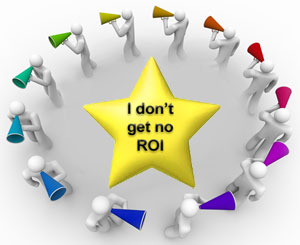 Rodney Dangerfield won fame and a cult following with his comedic catchphrase, “I don’t get no respect.” His signature line and self-deprecating ways kept people laughing for years. The tactics Rodney used then fits perfectly in our social media world today. When his comedy act failed to take off, he created a character that was always on the losing side. The image he developed launched his career and kept it going.
Rodney Dangerfield won fame and a cult following with his comedic catchphrase, “I don’t get no respect.” His signature line and self-deprecating ways kept people laughing for years. The tactics Rodney used then fits perfectly in our social media world today. When his comedy act failed to take off, he created a character that was always on the losing side. The image he developed launched his career and kept it going.
Was it Rodney’s success that inspired self-professed gurus to adopt an “I don’t get no ROI” mantra for social media? Maybe it was the need to differentiate the channel from traditional marketing. Or, could it be that the people professing its value to the corporate world didn’t understand the need for ROI? Whatever the motivation, the image of the emerging channel was hurt by the people declaring its worth. This is truly a shame because there is value, measurable value, in effective social media strategies.
Five years ago, corporate social media was in the early adoption stage. A few forward thinking companies were testing it. The rest were watching from the sidelines, skeptical about anything that wasn’t proven to generate revenue and profitability. The economy was presenting tough challenges. Investments needed to deliver revenue.
The first impression of the baby channel wasn’t good. Anyone who dared to mention a return on investment was chastised for not understanding that it was “all about the conversation.” This made people who understood business uncomfortable. How could they justify participating in a channel where discussion of ROI was taboo?
Time passes and the channel evolves. Platforms and tools are created. Rising social media rock stars passionately promoted the channel. They talked about transparency, engagement, connections, fans, followers, and likes, but ROI remained off limits. Real questions about the viability of social media receive flip replies. One of my favorite responses is, “What’s the ROI of your mother?” (Note: Adult language in video)
Answering a question with a question is a classic avoidance tactic. It directs the conversation away from the original topic. The people who do this either don’t want to share their knowledge or they don’t know the answer. Neither option endears business leaders to social media or its gurus. This is a disservice to the channel and the companies that need to have a presence.
Social media is increasingly becoming a cost of doing business. Credibility, in the form of a measurable return, is needed to justify investments. The argument that other channels aren’t measurable is false. They are, with the right mix of message and call to action. Admittedly, some advertising is created for the sole purpose of brand awareness. I’m not including branding messages in this discussion. For a direct marketer like me, brand awareness is a side effect, not a purpose.
Measuring the return from social media is similar to measuring the return from customer service. It isn’t easy or simple but it can be done. Companies participating in social activities have three choices when considering quantification. They are:
- Invest the resources required to implement a measurement strategy that defines the cause and effect.
- Treat social media as a cost of doing business like customer service.
- Maintain the status quo.
If you choose the first option, here are some tips to help you measure the unknown:
- Add trackable call to actions to content. This allows you to see how many people are responding and what they do.
- Establish and maintain benchmarks. Monitoring benchmarks identifies trends that can be used to evaluate strategy.
- Segment prospects and customers acquired via social platforms separately. Comparing their lifetime value to those acquired via traditional methods provides information for long-term investments.
- Include service costs in analysis. Social media is more of service channel than a marketing channel for some companies.
- Validate all data before using it. And, when in doubt validate it again. Social media analytics change quite often.
- Ignore all naysayers. ROI is a critical component of business analysis. Omitting it is poor management.
















